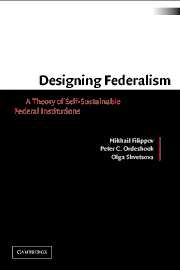Book contents
- Frontmatter
- Contents
- List of Figures
- List of Tables
- Preface
- Acknowledgments
- 1 Federations and the Theoretical Problem
- 2 Federal Bargaining
- 3 Two Cases of Uninstitutionalized Bargaining
- 4 Representation
- 5 Incentives
- 6 Political Parties in a Federal State
- 7 Institutional Sources of Federal Stability I
- 8 Institutional Sources of Federal Stability II
- 9 Designing Federalism
- References
- Name Index
- Subject Index
1 - Federations and the Theoretical Problem
Published online by Cambridge University Press: 03 December 2009
- Frontmatter
- Contents
- List of Figures
- List of Tables
- Preface
- Acknowledgments
- 1 Federations and the Theoretical Problem
- 2 Federal Bargaining
- 3 Two Cases of Uninstitutionalized Bargaining
- 4 Representation
- 5 Incentives
- 6 Political Parties in a Federal State
- 7 Institutional Sources of Federal Stability I
- 8 Institutional Sources of Federal Stability II
- 9 Designing Federalism
- References
- Name Index
- Subject Index
Summary
Federalism is the main alternative to empire as a technique of aggregating large areas under one government.
Riker 1964: 5Federalism is commonly understood as a theory of government that uses power to check power amid opposite and rival interests. Authority is limited, and no single body exercises supreme control nor has a monopoly over the use of force in society. But the idea of federalism is rendered trivial when applied only to the coexistence of state and national governments. Rather, federalism offers no less than an enabling basis for the development of self-organizing and self-governing capabilities under conditions of equal liberty and justice.
Ostrom 1991: xiWhy Federalism
Before we can develop the preceding argument, we should first consider the reasons why federalism is often deemed a desirable governmental form, along with some definitions and the classic explanations for federal political stability and instability. We can begin by noting that, at a more detailed level than the assertion by Riker with which we introduce this chapter, federalism has two general justifications, one economic and the other political.
The economic justification should be well known. Government (i.e., coercive) action may be required to resolve those market failures associated with informational asymmetries, externalities, and wholly decentralized decision making over public goods. However, public goods in particular vary in their characteristics, which, in turn, may require different treatments by different levels of government.
- Type
- Chapter
- Information
- Designing FederalismA Theory of Self-Sustainable Federal Institutions, pp. 1 - 41Publisher: Cambridge University PressPrint publication year: 2004



